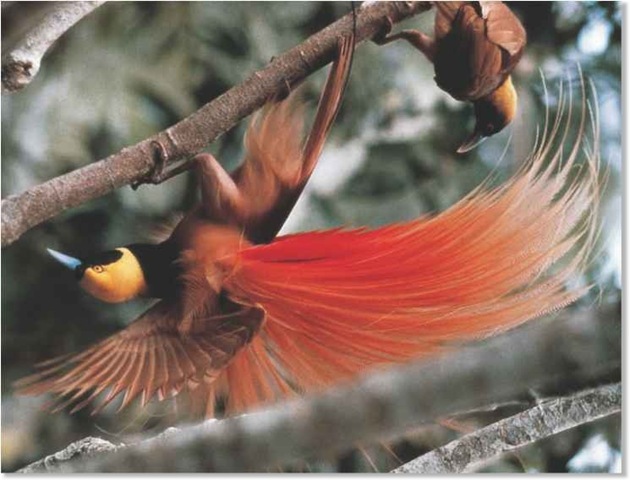ORDER
Passeriformes
FAMILY
Paradisaeidae
GENUS & SPECIES
KEY FEATURES
Bold plumage and a dazzling courtship display make it one of the wonders of the natural world Males dance in treetops, showing off bright-red, lacy plumes in cascades of shimmering color Female chooses the most impressive dancer for a mate, then raises her brood alone
WHERE IN THE WORLD!
In southern and eastern Papua New Guinea, from Milne Bay in the east, north to the Huon Peninsula, west almost to the border of Irian Jaya
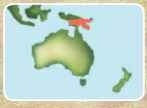
Lifecycle
The courtship dance of the male Raggiana bird of paradise begins at dawn. Wild cries ring through the forest as it competes with other males for mates, shaking its plumes.
HABITAT
The bird of paradise favors lowland rainforest, but is also found in mountain forests up to about 4,950′. Although it rarely leaves the tree canopy, it may visit open land at the woodland edge. Some trees are used regularly as display areas (leks) where up to 10 male birds gather to show off their flamboyant plumes.
In the constantly warm, humid rainforests, the Raggiana can find a tree in fruit at any time of year. As a result, it requires a foraging area of less than 0.2 sq. mile and can survive even in wooded gullies where the surrounding area has been deforested.

A Island beauty This bird of paradise is found only in the forests of eastern New Guinea.
Bird-watching The bird of paradise’s colorful plumage lets its displays be seen among the thickest foliage.
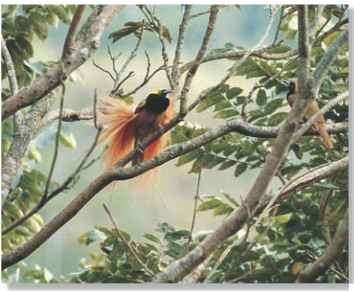
FOOD & FEEDING
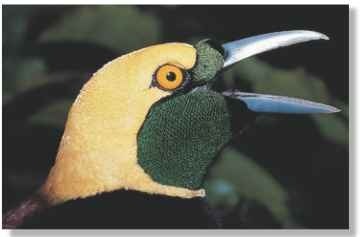
A Food bill Although its bill is best suited to eating fruit, the Raggiana is adept at snapping up insects.
Abundant fruits of forest trees form the main diet of the Raggiana. It also eats some insects found among the branches. As with other fruit-eating birds, young are raised almost exclusively on insects to give them the extra protein needed for growth. The female feeds them by regurgitating directly into their gaping mouths.
Plumed male Raggiana birds of paradise find most of their food close to their display trees. Females and young or molting males that don’t possess plumes may form small flocks — sometimes in the company of other species — and forage over a wider area.
Because native hunters removed the legs from the birds they killed, the first explorers believed that these birds were in fact wanderers from paradise, where they spent their whole lives in the air.
The Raggiana bird of paradise is featured on the national crest of Papua New Guinea.
BREEDING
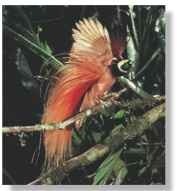
A Show-off
The dominant male will mate with several females.
BEHAVIOR
The spectacular plumage of the male Raggiana exists for one purpose — to attract a mate. Every morning in the breeding season, a group of plumed males gathers at the display area. Each bird claims and defends a bare branch in the rainforest canopy on which to show off his plumage to the females.
Dancing males announce their presence with a chorus of synchronized calls; their frenzy intensifies as females arrive to watch the show. The males’ courtship dance includes a number of set routines, not always performed in the same order; but all intended to heighten the effect of the brightly colored plumage.
Younger males, yet to acquire their plumes, go through the motions of the dance at the edges of the main display area, but usually get a chance to mate only when adult males are scarce.
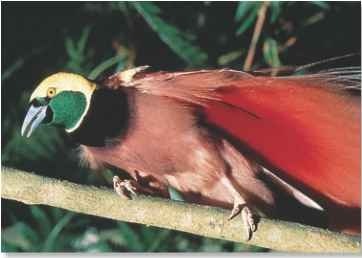
R.D OF THE DANCE
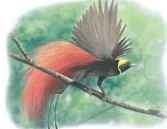
Clapping…
After some wing-fluttering, the Raggiana begins his main display by raising his wings and clapping them loudly over his back.
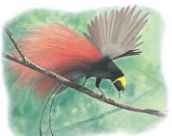
Quivering…
Leaning forward with head held down, the bird flicks his open wings to agitate the long flank plumes, forming a quivering cascade of color.
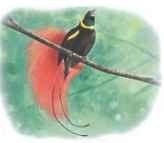
Calling.
Suddenly, he stands upright. Throwing back his head and calling loudly, he closes his wings, thrusts them down and hops sideways.
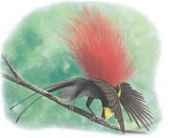
Bowing
Head bowed, the male points his plumes up, holding them still to show their undersides, while he awaits the female’s verdict.
The female chooses her favorite dancer from the males; mating takes place after a further flurry of bobbing and prancing. There’s usually one dominant (“alpha”) male, who’ll mate with the greatest number of females. This ability of one male to mate with many females and the ability of junior, unplumed males to breed when there’s no alpha, let the species survive the era of plume-hunting.
After mating, the female builds a cup-shaped nest in the fork of a tree, up to 66′ above the ground. She uses lengths of vine and dead leaves and lines the nest with soft palm leaf fibers. Eggs hatch after 20 days, and she continues to feed the chicks for more than a month after they fledge at about three weeks.
Waiting and watching The dull-colored female chooses a favorite male dancer, who continues to display until they mate.
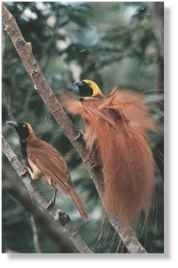
CONSERVATION
The bird of paradise is common through its range and has withstood centuries of hunting by Papuan tribes, who value its plumes for their headdresses. It was once hunted for the Western fashion trade, but this was outlawed in the 1920s. Habitat destruction is a long-term threat.
Profile
Raggiana Bird of Paradise
A bird built for display, the male spends up to five months of every year in molt — shedding his old feathers and growing a fresh set of plumes.
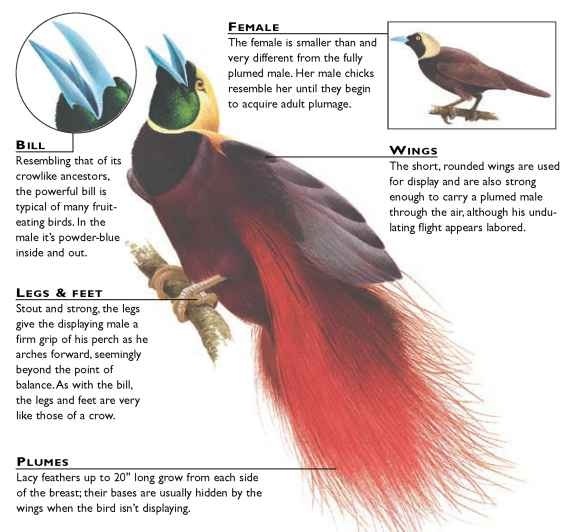
CREATURE COMPARISONS
The finery of the Raggiana bird of paradise is equaled by the blue bird of paradise, which displays upside down, flaring its wings and calling raucously. Wallace’s standardwing, with 6″ plumes from its wing edges, is one of the few birds of paradise that live outside New Guinea — on the Moluccan Islands.
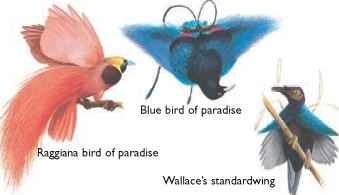
| VITAL STATISTICS Weight |
Male 11-12 oz.; female 6-7 oz. |
| Length | Male 28″ with plumes; female 11″ |
| Wingspan | 19-25″ |
| Sexual Maturity | Male 4-6 years; female 2 years |
| Breeding season | September -November |
| Number of Eggs | 1 or 2 |
| Incubation Period | About 20 days |
| Fledging Period | 19-20 days |
| Typical Diet Lifespan |
Mainly fruit; some insects |
| Probably up to 16 years | |
RELATED SPECIES
• Most of the 43 bird of paradise species live in Papua New Guinea, including the red bird of paradise (below); a few are found in the Moluccan Islands and Australia.
